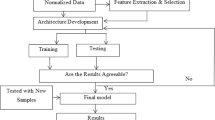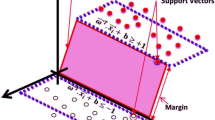Abstract
In a developed society, people have more concerned about their health. Thus, improvement of medical field application has been one of the greatest active study areas. Medical statistics show that heart disease is the main reason for morbidity and death in the world. The physician’s job is difficult because of having too many factors to analyze in the diagnosis of heart disease. Besides, data and information gained by the physician for diagnosis are often partial and immersed. Recently, health care applications with the Internet of Things (IoT) have offered different dimensions and other online services. These applications have provided a new platform for millions of people to receive benefits from the regular health tips to live a healthy life. In this paper, we propose a novel framework based on computer supported diagnosis and IoT to detect and monitor heart failure infected patients, where the data are attained from various other sources. The proposed healthcare system aims at obtaining better precision of diagnosis with ambiguous information. We suggest neutrosophic multi criteria decision making (NMCDM) technique to aid patient and physician to know if patient is suffering from heart failure. Furthermore, through dealing with the uncertainty of imprecision and vagueness resulted from the symmetrical priority scales of different symptoms of disease, users know what extent the disease is dangerous in their body. The proposed model is validated by numerical examples on real case studies. The experimental results indicate that the proposed system provides a viable solution that can work at wide range, a new platform to millions of people getting benefit over the decreasing of mortality and cost of clinical treatment related to heart failure.












Similar content being viewed by others
References
Abdel-Basset M, El-Shahat D, El-Henawy IM, Sangaiah AK (2018) A modified flower pollination algorithm for the multidimensional knapsack problem: human-centric decision making. Soft Comput 22(13):4221–4239
Abdel-Basset M, Gunasekaran M, Mohamed M, Smarandache F (2018) A novel method for solving the fully neutrosophic linear programming problems. https://doi.org/10.1007/s00521-018-3404-6
Abdel-Basset M, Mohamed M, Hussien A-N, Sangaiah AK (2018) A novel group decision-making model based on triangular neutrosophic numbers. Soft Comput 22(20):6629–6643
Abdel-Basset M, Mohamed M, Sangaiah AK (2018) Neutrosophic AHP-Delphi Group decision making model based on trapezoidal neutrosophic numbers. J Ambient Intell Humaniz Comput 9(5):1427–1443
Abdel-Basset M, Mohamed M, Zhou Y, Hezam I (2017) Multi-criteria group decision making based on neutrosophic analytic hierarchy process. J Intell Fuzzy Syst 33(6):4055–4066
Abdel-Basset M, Zhou Y, Mohamed M, Chang V (2018) A group decision making framework based on neutrosophic VIKOR approach for e-government website evaluation. J Intell Fuzzy Syst 34(6):4213–4224
Al Hemairy M et al (2018) A Comprehensive Framework for Elderly Healthcare Monitoring in Smart Environment. Technology for Smart Futures, Springer:113–140
Ali M, Dat LQ, Son LH, Smarandache F (2018) Interval Complex Neutrosophic Set: Formulation and Applications in Decision-Making. International Journal of Fuzzy Systems 20(3):986–999
Ali M, Son LH, Deli I, Tien ND (2017) Bipolar Neutrosophic Soft Sets and Applications in Decision Making. J Intell Fuzzy Syst 33:4077–4087
Ali M, Son LH, Thanh ND, Minh NV (2018) A neutrosophic recommender system for medical diagnosis based on algebraic neutrosophic measures. Appl Soft Comput 71:1054–1071
Alshurafa N et al (2017) Remote health monitoring outcome success prediction using baseline and first month intervention data. IEEE Journal of Biomedical and Health Informatics 21(2):507–514
Bhatla N, Jyoti K (2012) A Novel Approach for Heart Disease Diagnosis using Data Mining and Fuzzy Logic. Int J Comput Appl 54(17):16–21
Da Costa CA, Pasluosta CF, Eskofier B, da Silva DB, da Rosa Righi R (2018) Internet of Health Things: Toward intelligent vital signs monitoring in hospital wards. Artif Intell Med 89:61–69. https://doi.org/10.1016/j.artmed.2018.05.005
Das A et al (2019) Distributed machine learning cloud teleophthalmology IoT for predicting AMD disease progression. Futur Gener Comput Syst 93:486–498
Dat LQ, Thong NT, Le HS, Ali M, Smarandache F, Abdel-Basset M, Long HV (2019) Linguistic Approaches to Interval Complex Neutrosophic Sets in Decision Making. IEEE Access 7:38902–38917
Deli I et al (2015) Bipolar neutrosophic sets and their application based on multi-criteria decision making problems. arXiv preprint arXiv:1504.02773
Firouzi F, Rahmani AM, Mankodiya K, Badaroglu M, Merrett GV, Wong P, Farahani B (2018) Internet-of-Things and big data for smarter healthcare: From device to architecture, applications and analytics. Futur Gener Comput Syst 78:583–586. https://doi.org/10.1016/j.future.2017.09.016
Gravina R et al (2017) Multi-sensor fusion in body sensor networks: State-of-the-art and research challenges. Information Fusion 35:68–80
Haghi M et al (2017) Wearable devices in medical internet of things: scientific research and commercially available devices. Healthcare Informatics Research 23(1):4–15
Ho W, Xu X, Dey PK (2010) Multi-criteria decision making approaches for supplier evaluation and selection: A literature review. Eur J Oper Res 202(1):16–24
Jha S, Kumar R, Le HS, Chatterjee JM, Khari M, Yadav N, Smarandache F (2019) Neutrosophic soft set decision making for stock trending analysis. Evol Syst, in press. https://doi.org/10.1007/s12530-018-9247-7
Kalantari A et al (2018) Computational intelligence approaches for classification of medical data: State-of-the-art, future challenges and research directions. Neurocomputing 276:2–22
Khan M, Hoang Son L, Ali M, Chau HTM, Na NTN, Smarandache F (2018) Systematic Review of Decision Making Algorithms in Extended Neutrosophic Sets. Symmetry-Basel 10:314–342
Kumar PM et al (2018) Cloud and IoT based disease prediction and diagnosis system for healthcare using Fuzzy neural classifier. Futur Gener Comput Syst 86:527–534
Li C, Hu X, Zhang L (2017) The IoT-based heart disease monitoring system for pervasive healthcare service. Procedia Computer Science 112:2328–2334
Long HV (2018) On fuzzy random fractional partial interger-differential equations under Caputo generalized Hukuhara diferentiability. Comput Appl Math 37(3):2738–2765
Long HV, Ali M, Son LH, Khan M, Tu DN (2019) A novel approach for fuzzy clustering based on neutrosophic association matrix. Comput Ind Eng 127:687–697
Long HV, Son NTK, Ha NTM, Son LH (2014) The existence and uniqueness of fuzzy solutions for hyperbolic partial differential equations. Fuzzy Optim Decis Making 13(4):435–462
Long HV, Son NTK, Rodróguez-López R (2018) Some Generalizations of fixed point theorems in partially ordered metric spaces and applications to partial differential equations with uncertainty. Vietnam J Math 46(3):531–555
Manogaran G et al (2018) A new architecture of Internet of Things and big data ecosystem for secured smart healthcare monitoring and alerting system. Futur Gener Comput Syst 82:375–387
Nazari S et al (2018) A fuzzy inference-fuzzy analytic hierarchy process-based clinical decision support system for diagnosis of heart diseases. Expert Syst Appl 95:261–271
Nedungadi P et al (2018) Personalized health monitoring system for managing well-being in rural areas. J Med Syst 42(1):22
Ngan RT, Son LH, Cuong BC, Ali M (2018) H-max distance measure of intuitionistic fuzzy sets in decision making. Appl Soft Comput 69:393–425
Ngan TT, Tuan TM, Son LH, Minh NH, Dey N (2016) Decision making based on fuzzy aggregation operators for medical diagnosis from dental X-ray images. J Med Syst 40(12):1–7
Nguyen Gia T, Dhaou IB, Ali M, Rahmani AM, Westerlund T, Liljeberg P, Tenhunen H (2019) Energy efficient fog-assisted IoT system for monitoring diabetic patients with cardiovascular disease. Futur Gener Comput Syst 93:198–211
Nguyen GN, Son LH, Ashour AS, Dey N (2019) A survey of the state-of-the-arts on neutrosophic sets in biomedical diagnoses. Int J Mach Learn Cybern 10(1):1–13
Rahmani AM et al (2018) Exploiting smart e-Health gateways at the edge of healthcare Internet-of-Things: A fog computing approach. Futur Gener Comput Syst 78:641–658
Riedel O et al (2018) The contribution of comorbidities to mortality in hospitalized patients with heart failure. Clin Res Cardiol 107(6):487–497
Sagir AM, Sathasivam S (2017) A Hybridised Intelligent Technique for the Diagnosis of Medical Diseases. Pertanika Journal of Science & Technology 25(2)
Samuel OW et al (2017) An integrated decision support system based on ANN and Fuzzy_AHP for heart failure risk prediction. Expert Syst Appl 68:163–172
Sehra SK, Brar D, Singh Y, Kaur D (2013) Multi criteria decision making approach for selecting effort estimation model. arXiv preprint arXiv:1310.5220
Son NTK, Dong NP, Son LH, Long HV Towards granular calculus of single-valued neutrosophic functions under granular computing. Multimed Tools Appl. https://doi.org/10.1007/s11042-019-7388-8
Thong NT, Dat LQ, Son LH, Hoa ND, Ali M, Smarandache F (2019) Dynamic Interval Valued Neutrosophic Set: Modeling Decision Making in Dynamic Environments. Comput Ind in press
V P, D G (2018) A novel approach for diagnosing heart disease with hybrid classifier. Biomed Res 29(11):2274–2280
Verma P, Sood SK (2018) Cloud-centric IoT based disease diagnosis healthcare framework. Journal of Parallel and Distributed Computing 116:27–38
Verma P et al (2018) Cloud-centric IoT based student healthcare monitoring framework. J Ambient Intell Humaniz Comput 9(5):1293–1309
Wang Y et al (2018) Big data analytics: Understanding its capabilities and potential benefits for healthcare organizations. Technol Forecast Soc Chang 126:3–13
Xu B et al (2017) The design of an m-Health monitoring system based on a cloud computing platform. Enterprise Information Systems 11(1):17–36
YIN Y, Zeng Y, Chen X, Fan Y (2016) The internet of things in healthcare: An overview. J Ind Inf Integr 1:3–13. https://doi.org/10.1016/j.jii.2016.03.004
Acknowledgements
This research is funded by Vietnam National Foundation for Science and Technology Development (NAFOSTED) under grant number 102.05-2018.02.
Author information
Authors and Affiliations
Corresponding author
Additional information
Publisher’s note
Springer Nature remains neutral with regard to jurisdictional claims in published maps and institutional affiliations.
Rights and permissions
About this article
Cite this article
Abdel-Basset, M., Gamal, A., Manogaran, G. et al. A novel group decision making model based on neutrosophic sets for heart disease diagnosis. Multimed Tools Appl 79, 9977–10002 (2020). https://doi.org/10.1007/s11042-019-07742-7
Received:
Revised:
Accepted:
Published:
Issue Date:
DOI: https://doi.org/10.1007/s11042-019-07742-7




